James Cook University: Tourism Development in Tropical Australia
VerifiedAdded on 2022/09/25
|57
|20782
|20
Report
AI Summary
This report, authored by Dr. Philip L. Pearce from James Cook University, presents a comprehensive analysis of tourism development initiatives in tropical Australia. The study, published by The Cairns Institute, explores key areas for growth, including community well-being, cross-industry opportunities, and the reinforcement of the natural brand. It emphasizes the importance of Indigenous opportunities, the slow tourism approach, and supporting domestic tourism. The report also addresses the need for consolidating international strategies, integrating quality markers, attending to research investment, and refreshing educational structures. The author provides a detailed framework for innovation, considering intelligence, industry capabilities, information technology, and investment. The report concludes with a call for a community-based competition to foster innovative public infrastructure projects to boost tourism. The document is available on Desklib, a platform offering valuable resources for students.
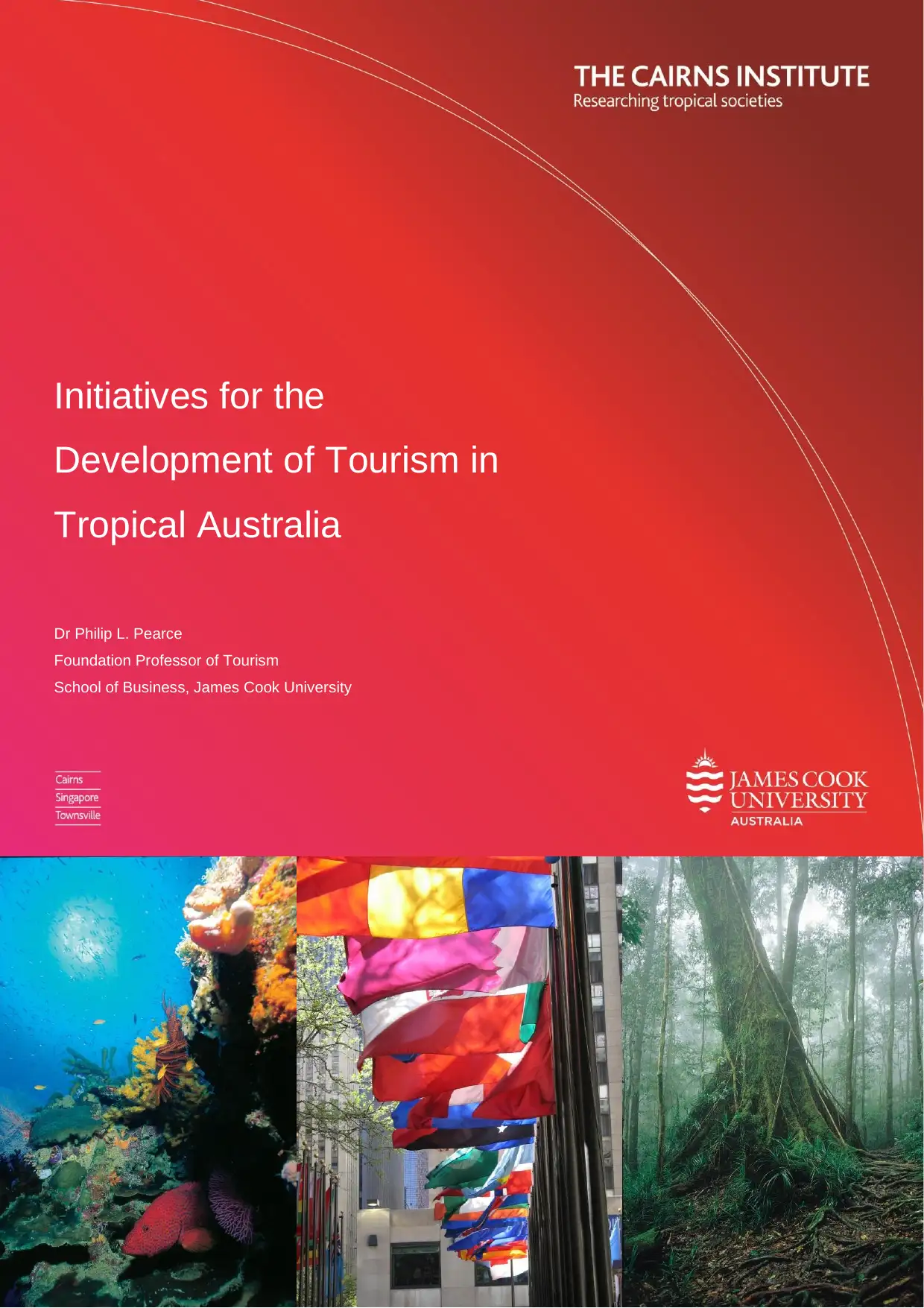
Initiatives for the
Development of Tourism in
Tropical Australia
Dr Philip L. Pearce
Foundation Professor of Tourism
School of Business, James Cook University
Development of Tourism in
Tropical Australia
Dr Philip L. Pearce
Foundation Professor of Tourism
School of Business, James Cook University
Paraphrase This Document
Need a fresh take? Get an instant paraphrase of this document with our AI Paraphraser
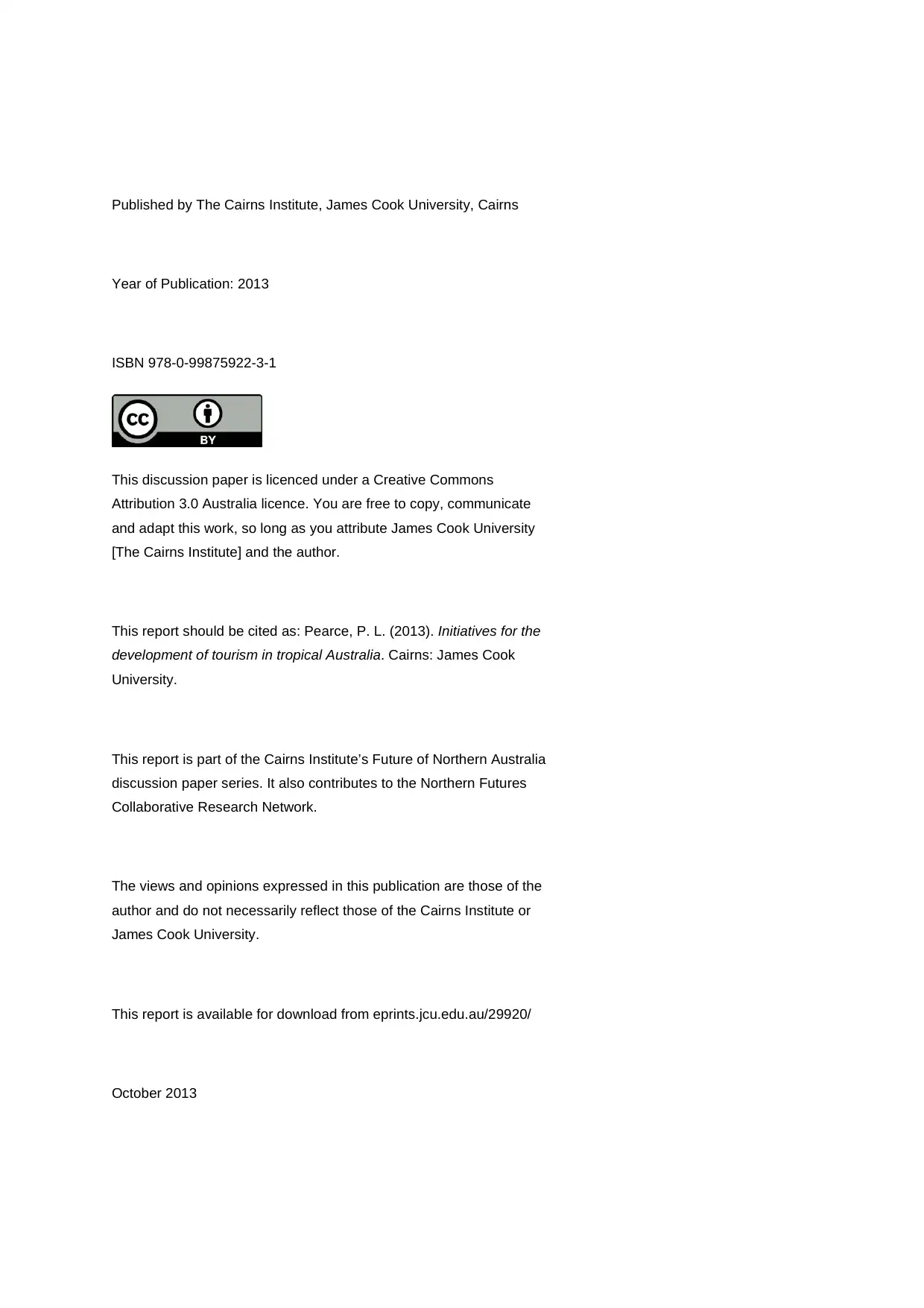
Published by The Cairns Institute, James Cook University, Cairns
Year of Publication: 2013
ISBN 978-0-99875922-3-1
This discussion paper is licenced under a Creative Commons
Attribution 3.0 Australia licence. You are free to copy, communicate
and adapt this work, so long as you attribute James Cook University
[The Cairns Institute] and the author.
This report should be cited as: Pearce, P. L. (2013). Initiatives for the
development of tourism in tropical Australia. Cairns: James Cook
University.
This report is part of the Cairns Institute’s Future of Northern Australia
discussion paper series. It also contributes to the Northern Futures
Collaborative Research Network.
The views and opinions expressed in this publication are those of the
author and do not necessarily reflect those of the Cairns Institute or
James Cook University.
This report is available for download from eprints.jcu.edu.au/29920/
October 2013
Year of Publication: 2013
ISBN 978-0-99875922-3-1
This discussion paper is licenced under a Creative Commons
Attribution 3.0 Australia licence. You are free to copy, communicate
and adapt this work, so long as you attribute James Cook University
[The Cairns Institute] and the author.
This report should be cited as: Pearce, P. L. (2013). Initiatives for the
development of tourism in tropical Australia. Cairns: James Cook
University.
This report is part of the Cairns Institute’s Future of Northern Australia
discussion paper series. It also contributes to the Northern Futures
Collaborative Research Network.
The views and opinions expressed in this publication are those of the
author and do not necessarily reflect those of the Cairns Institute or
James Cook University.
This report is available for download from eprints.jcu.edu.au/29920/
October 2013
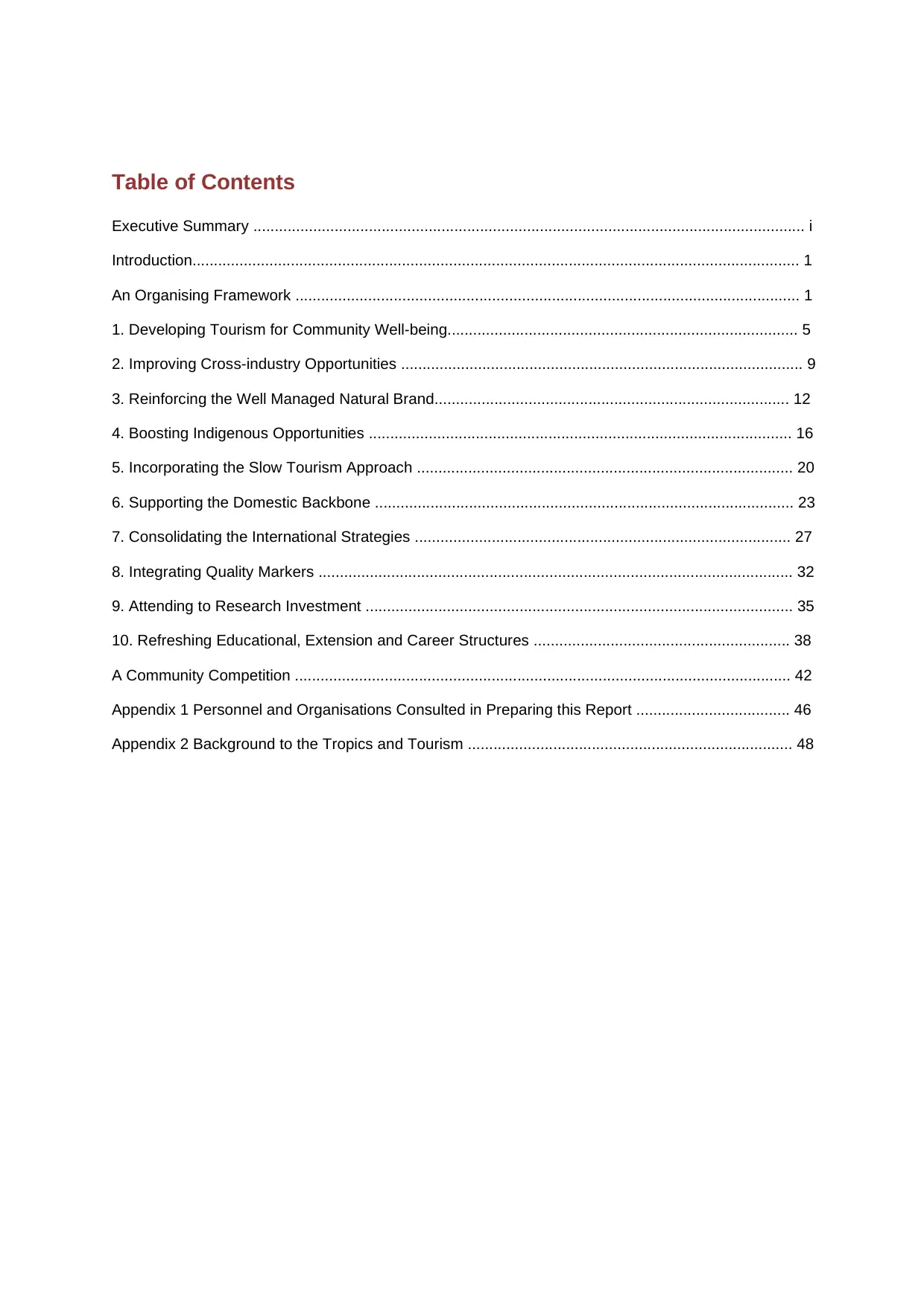
Table of Contents
Executive Summary ................................................................................................................................. i
Introduction.............................................................................................................................................. 1
An Organising Framework ...................................................................................................................... 1
1. Developing Tourism for Community Well-being.................................................................................. 5
2. Improving Cross-industry Opportunities .............................................................................................. 9
3. Reinforcing the Well Managed Natural Brand................................................................................... 12
4. Boosting Indigenous Opportunities ................................................................................................... 16
5. Incorporating the Slow Tourism Approach ........................................................................................ 20
6. Supporting the Domestic Backbone .................................................................................................. 23
7. Consolidating the International Strategies ........................................................................................ 27
8. Integrating Quality Markers ............................................................................................................... 32
9. Attending to Research Investment .................................................................................................... 35
10. Refreshing Educational, Extension and Career Structures ............................................................ 38
A Community Competition .................................................................................................................... 42
Appendix 1 Personnel and Organisations Consulted in Preparing this Report .................................... 46
Appendix 2 Background to the Tropics and Tourism ............................................................................ 48
Executive Summary ................................................................................................................................. i
Introduction.............................................................................................................................................. 1
An Organising Framework ...................................................................................................................... 1
1. Developing Tourism for Community Well-being.................................................................................. 5
2. Improving Cross-industry Opportunities .............................................................................................. 9
3. Reinforcing the Well Managed Natural Brand................................................................................... 12
4. Boosting Indigenous Opportunities ................................................................................................... 16
5. Incorporating the Slow Tourism Approach ........................................................................................ 20
6. Supporting the Domestic Backbone .................................................................................................. 23
7. Consolidating the International Strategies ........................................................................................ 27
8. Integrating Quality Markers ............................................................................................................... 32
9. Attending to Research Investment .................................................................................................... 35
10. Refreshing Educational, Extension and Career Structures ............................................................ 38
A Community Competition .................................................................................................................... 42
Appendix 1 Personnel and Organisations Consulted in Preparing this Report .................................... 46
Appendix 2 Background to the Tropics and Tourism ............................................................................ 48
⊘ This is a preview!⊘
Do you want full access?
Subscribe today to unlock all pages.

Trusted by 1+ million students worldwide
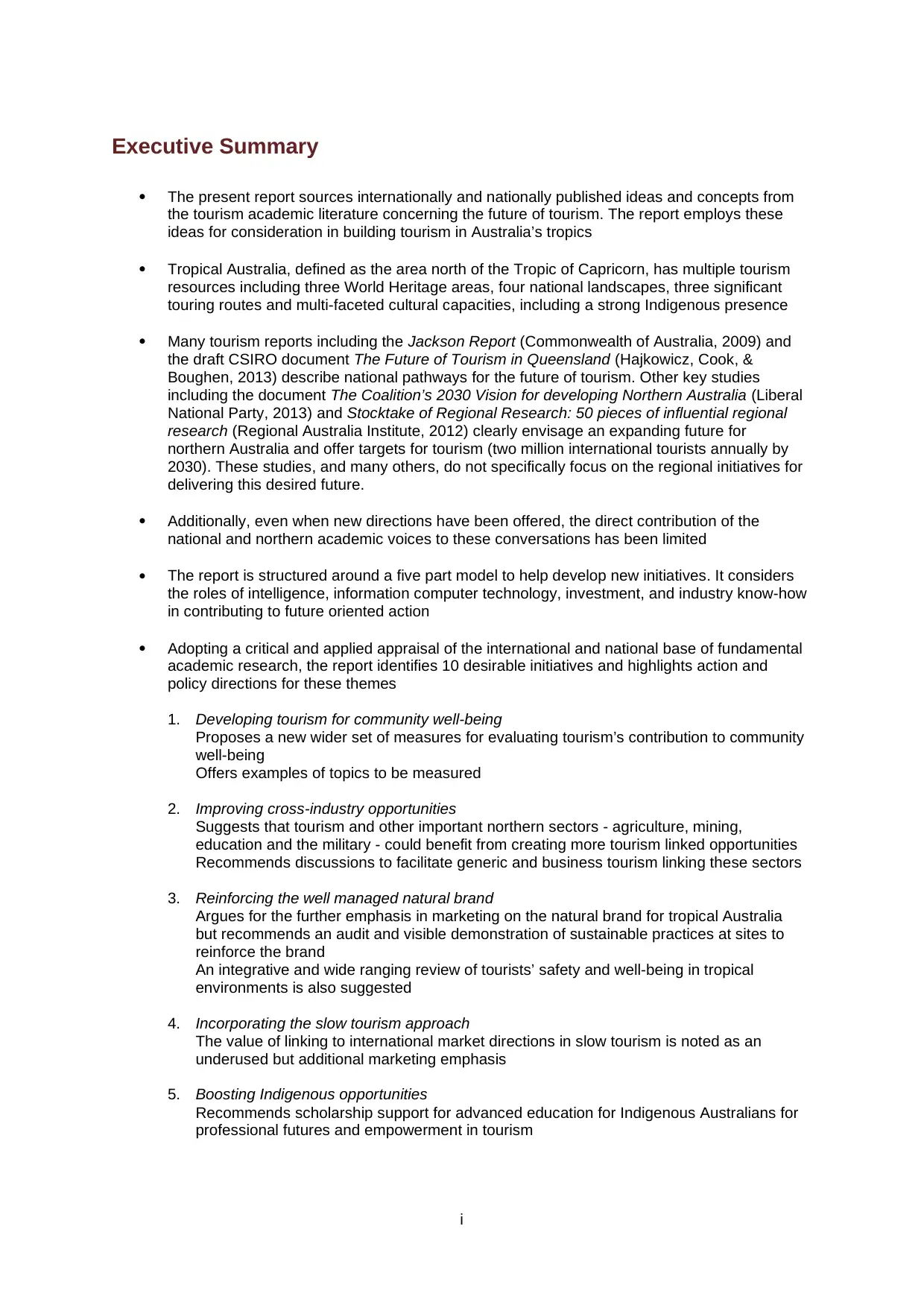
i
Executive Summary
The present report sources internationally and nationally published ideas and concepts from
the tourism academic literature concerning the future of tourism. The report employs these
ideas for consideration in building tourism in Australia’s tropics
Tropical Australia, defined as the area north of the Tropic of Capricorn, has multiple tourism
resources including three World Heritage areas, four national landscapes, three significant
touring routes and multi-faceted cultural capacities, including a strong Indigenous presence
Many tourism reports including the Jackson Report (Commonwealth of Australia, 2009) and
the draft CSIRO document The Future of Tourism in Queensland (Hajkowicz, Cook, &
Boughen, 2013) describe national pathways for the future of tourism. Other key studies
including the document The Coalition’s 2030 Vision for developing Northern Australia (Liberal
National Party, 2013) and Stocktake of Regional Research: 50 pieces of influential regional
research (Regional Australia Institute, 2012) clearly envisage an expanding future for
northern Australia and offer targets for tourism (two million international tourists annually by
2030). These studies, and many others, do not specifically focus on the regional initiatives for
delivering this desired future.
Additionally, even when new directions have been offered, the direct contribution of the
national and northern academic voices to these conversations has been limited
The report is structured around a five part model to help develop new initiatives. It considers
the roles of intelligence, information computer technology, investment, and industry know-how
in contributing to future oriented action
Adopting a critical and applied appraisal of the international and national base of fundamental
academic research, the report identifies 10 desirable initiatives and highlights action and
policy directions for these themes
1. Developing tourism for community well-being
Proposes a new wider set of measures for evaluating tourism’s contribution to community
well-being
Offers examples of topics to be measured
2. Improving cross-industry opportunities
Suggests that tourism and other important northern sectors - agriculture, mining,
education and the military - could benefit from creating more tourism linked opportunities
Recommends discussions to facilitate generic and business tourism linking these sectors
3. Reinforcing the well managed natural brand
Argues for the further emphasis in marketing on the natural brand for tropical Australia
but recommends an audit and visible demonstration of sustainable practices at sites to
reinforce the brand
An integrative and wide ranging review of tourists’ safety and well-being in tropical
environments is also suggested
4. Incorporating the slow tourism approach
The value of linking to international market directions in slow tourism is noted as an
underused but additional marketing emphasis
5. Boosting Indigenous opportunities
Recommends scholarship support for advanced education for Indigenous Australians for
professional futures and empowerment in tourism
Executive Summary
The present report sources internationally and nationally published ideas and concepts from
the tourism academic literature concerning the future of tourism. The report employs these
ideas for consideration in building tourism in Australia’s tropics
Tropical Australia, defined as the area north of the Tropic of Capricorn, has multiple tourism
resources including three World Heritage areas, four national landscapes, three significant
touring routes and multi-faceted cultural capacities, including a strong Indigenous presence
Many tourism reports including the Jackson Report (Commonwealth of Australia, 2009) and
the draft CSIRO document The Future of Tourism in Queensland (Hajkowicz, Cook, &
Boughen, 2013) describe national pathways for the future of tourism. Other key studies
including the document The Coalition’s 2030 Vision for developing Northern Australia (Liberal
National Party, 2013) and Stocktake of Regional Research: 50 pieces of influential regional
research (Regional Australia Institute, 2012) clearly envisage an expanding future for
northern Australia and offer targets for tourism (two million international tourists annually by
2030). These studies, and many others, do not specifically focus on the regional initiatives for
delivering this desired future.
Additionally, even when new directions have been offered, the direct contribution of the
national and northern academic voices to these conversations has been limited
The report is structured around a five part model to help develop new initiatives. It considers
the roles of intelligence, information computer technology, investment, and industry know-how
in contributing to future oriented action
Adopting a critical and applied appraisal of the international and national base of fundamental
academic research, the report identifies 10 desirable initiatives and highlights action and
policy directions for these themes
1. Developing tourism for community well-being
Proposes a new wider set of measures for evaluating tourism’s contribution to community
well-being
Offers examples of topics to be measured
2. Improving cross-industry opportunities
Suggests that tourism and other important northern sectors - agriculture, mining,
education and the military - could benefit from creating more tourism linked opportunities
Recommends discussions to facilitate generic and business tourism linking these sectors
3. Reinforcing the well managed natural brand
Argues for the further emphasis in marketing on the natural brand for tropical Australia
but recommends an audit and visible demonstration of sustainable practices at sites to
reinforce the brand
An integrative and wide ranging review of tourists’ safety and well-being in tropical
environments is also suggested
4. Incorporating the slow tourism approach
The value of linking to international market directions in slow tourism is noted as an
underused but additional marketing emphasis
5. Boosting Indigenous opportunities
Recommends scholarship support for advanced education for Indigenous Australians for
professional futures and empowerment in tourism
Paraphrase This Document
Need a fresh take? Get an instant paraphrase of this document with our AI Paraphraser
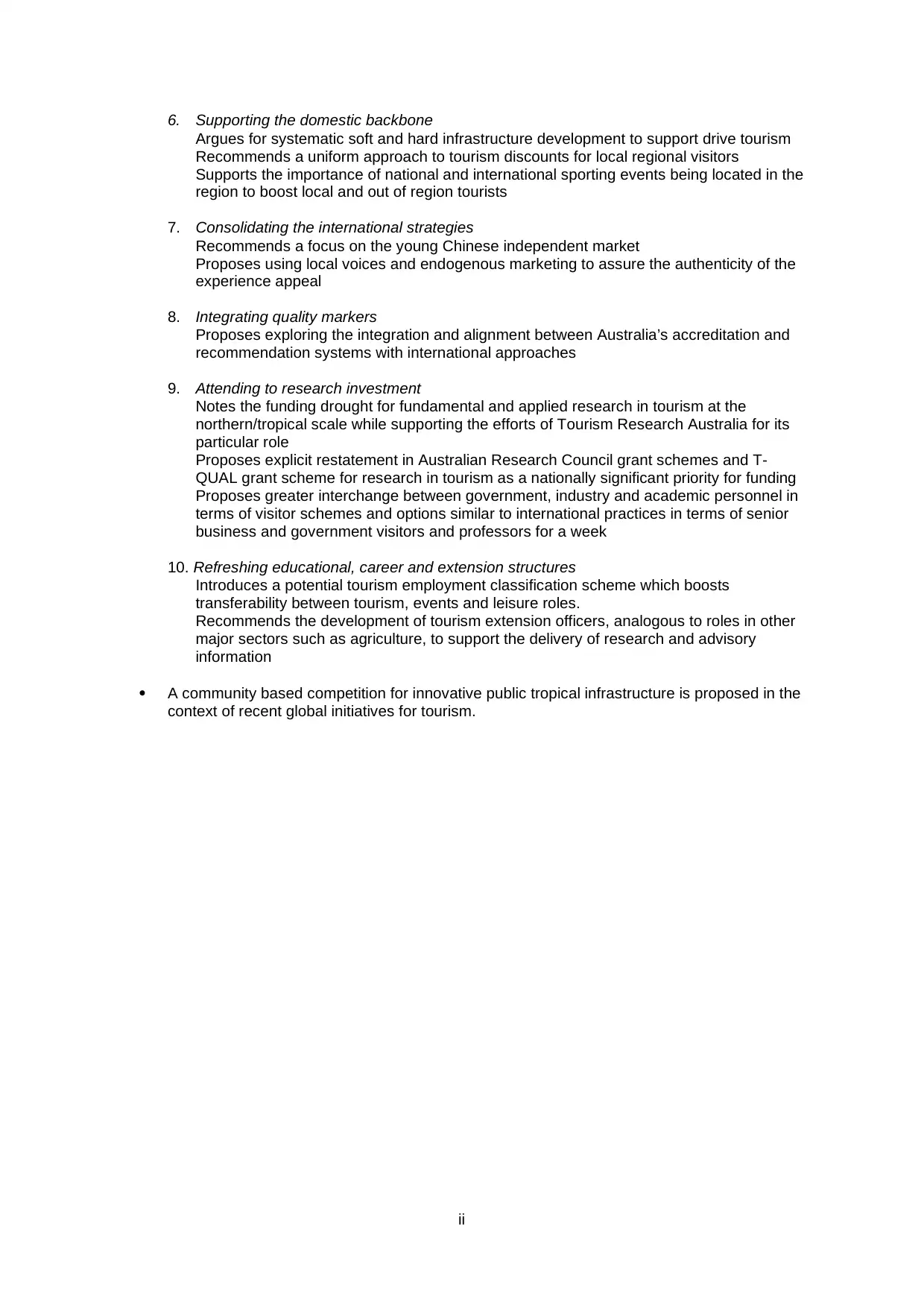
ii
6. Supporting the domestic backbone
Argues for systematic soft and hard infrastructure development to support drive tourism
Recommends a uniform approach to tourism discounts for local regional visitors
Supports the importance of national and international sporting events being located in the
region to boost local and out of region tourists
7. Consolidating the international strategies
Recommends a focus on the young Chinese independent market
Proposes using local voices and endogenous marketing to assure the authenticity of the
experience appeal
8. Integrating quality markers
Proposes exploring the integration and alignment between Australia’s accreditation and
recommendation systems with international approaches
9. Attending to research investment
Notes the funding drought for fundamental and applied research in tourism at the
northern/tropical scale while supporting the efforts of Tourism Research Australia for its
particular role
Proposes explicit restatement in Australian Research Council grant schemes and T-
QUAL grant scheme for research in tourism as a nationally significant priority for funding
Proposes greater interchange between government, industry and academic personnel in
terms of visitor schemes and options similar to international practices in terms of senior
business and government visitors and professors for a week
10. Refreshing educational, career and extension structures
Introduces a potential tourism employment classification scheme which boosts
transferability between tourism, events and leisure roles.
Recommends the development of tourism extension officers, analogous to roles in other
major sectors such as agriculture, to support the delivery of research and advisory
information
A community based competition for innovative public tropical infrastructure is proposed in the
context of recent global initiatives for tourism.
6. Supporting the domestic backbone
Argues for systematic soft and hard infrastructure development to support drive tourism
Recommends a uniform approach to tourism discounts for local regional visitors
Supports the importance of national and international sporting events being located in the
region to boost local and out of region tourists
7. Consolidating the international strategies
Recommends a focus on the young Chinese independent market
Proposes using local voices and endogenous marketing to assure the authenticity of the
experience appeal
8. Integrating quality markers
Proposes exploring the integration and alignment between Australia’s accreditation and
recommendation systems with international approaches
9. Attending to research investment
Notes the funding drought for fundamental and applied research in tourism at the
northern/tropical scale while supporting the efforts of Tourism Research Australia for its
particular role
Proposes explicit restatement in Australian Research Council grant schemes and T-
QUAL grant scheme for research in tourism as a nationally significant priority for funding
Proposes greater interchange between government, industry and academic personnel in
terms of visitor schemes and options similar to international practices in terms of senior
business and government visitors and professors for a week
10. Refreshing educational, career and extension structures
Introduces a potential tourism employment classification scheme which boosts
transferability between tourism, events and leisure roles.
Recommends the development of tourism extension officers, analogous to roles in other
major sectors such as agriculture, to support the delivery of research and advisory
information
A community based competition for innovative public tropical infrastructure is proposed in the
context of recent global initiatives for tourism.
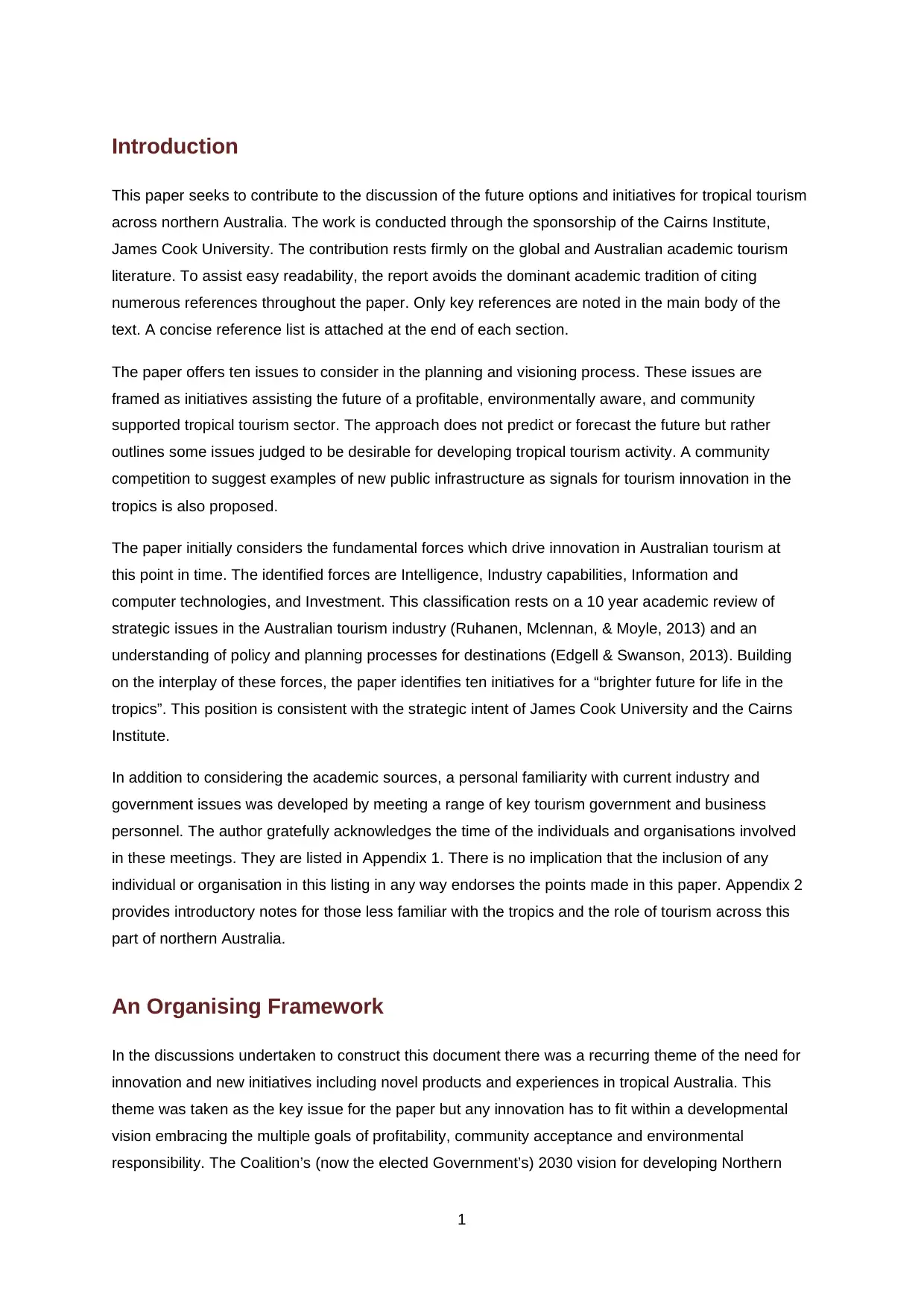
1
Introduction
This paper seeks to contribute to the discussion of the future options and initiatives for tropical tourism
across northern Australia. The work is conducted through the sponsorship of the Cairns Institute,
James Cook University. The contribution rests firmly on the global and Australian academic tourism
literature. To assist easy readability, the report avoids the dominant academic tradition of citing
numerous references throughout the paper. Only key references are noted in the main body of the
text. A concise reference list is attached at the end of each section.
The paper offers ten issues to consider in the planning and visioning process. These issues are
framed as initiatives assisting the future of a profitable, environmentally aware, and community
supported tropical tourism sector. The approach does not predict or forecast the future but rather
outlines some issues judged to be desirable for developing tropical tourism activity. A community
competition to suggest examples of new public infrastructure as signals for tourism innovation in the
tropics is also proposed.
The paper initially considers the fundamental forces which drive innovation in Australian tourism at
this point in time. The identified forces are Intelligence, Industry capabilities, Information and
computer technologies, and Investment. This classification rests on a 10 year academic review of
strategic issues in the Australian tourism industry (Ruhanen, Mclennan, & Moyle, 2013) and an
understanding of policy and planning processes for destinations (Edgell & Swanson, 2013). Building
on the interplay of these forces, the paper identifies ten initiatives for a “brighter future for life in the
tropics”. This position is consistent with the strategic intent of James Cook University and the Cairns
Institute.
In addition to considering the academic sources, a personal familiarity with current industry and
government issues was developed by meeting a range of key tourism government and business
personnel. The author gratefully acknowledges the time of the individuals and organisations involved
in these meetings. They are listed in Appendix 1. There is no implication that the inclusion of any
individual or organisation in this listing in any way endorses the points made in this paper. Appendix 2
provides introductory notes for those less familiar with the tropics and the role of tourism across this
part of northern Australia.
An Organising Framework
In the discussions undertaken to construct this document there was a recurring theme of the need for
innovation and new initiatives including novel products and experiences in tropical Australia. This
theme was taken as the key issue for the paper but any innovation has to fit within a developmental
vision embracing the multiple goals of profitability, community acceptance and environmental
responsibility. The Coalition’s (now the elected Government’s) 2030 vision for developing Northern
Introduction
This paper seeks to contribute to the discussion of the future options and initiatives for tropical tourism
across northern Australia. The work is conducted through the sponsorship of the Cairns Institute,
James Cook University. The contribution rests firmly on the global and Australian academic tourism
literature. To assist easy readability, the report avoids the dominant academic tradition of citing
numerous references throughout the paper. Only key references are noted in the main body of the
text. A concise reference list is attached at the end of each section.
The paper offers ten issues to consider in the planning and visioning process. These issues are
framed as initiatives assisting the future of a profitable, environmentally aware, and community
supported tropical tourism sector. The approach does not predict or forecast the future but rather
outlines some issues judged to be desirable for developing tropical tourism activity. A community
competition to suggest examples of new public infrastructure as signals for tourism innovation in the
tropics is also proposed.
The paper initially considers the fundamental forces which drive innovation in Australian tourism at
this point in time. The identified forces are Intelligence, Industry capabilities, Information and
computer technologies, and Investment. This classification rests on a 10 year academic review of
strategic issues in the Australian tourism industry (Ruhanen, Mclennan, & Moyle, 2013) and an
understanding of policy and planning processes for destinations (Edgell & Swanson, 2013). Building
on the interplay of these forces, the paper identifies ten initiatives for a “brighter future for life in the
tropics”. This position is consistent with the strategic intent of James Cook University and the Cairns
Institute.
In addition to considering the academic sources, a personal familiarity with current industry and
government issues was developed by meeting a range of key tourism government and business
personnel. The author gratefully acknowledges the time of the individuals and organisations involved
in these meetings. They are listed in Appendix 1. There is no implication that the inclusion of any
individual or organisation in this listing in any way endorses the points made in this paper. Appendix 2
provides introductory notes for those less familiar with the tropics and the role of tourism across this
part of northern Australia.
An Organising Framework
In the discussions undertaken to construct this document there was a recurring theme of the need for
innovation and new initiatives including novel products and experiences in tropical Australia. This
theme was taken as the key issue for the paper but any innovation has to fit within a developmental
vision embracing the multiple goals of profitability, community acceptance and environmental
responsibility. The Coalition’s (now the elected Government’s) 2030 vision for developing Northern
⊘ This is a preview!⊘
Do you want full access?
Subscribe today to unlock all pages.

Trusted by 1+ million students worldwide
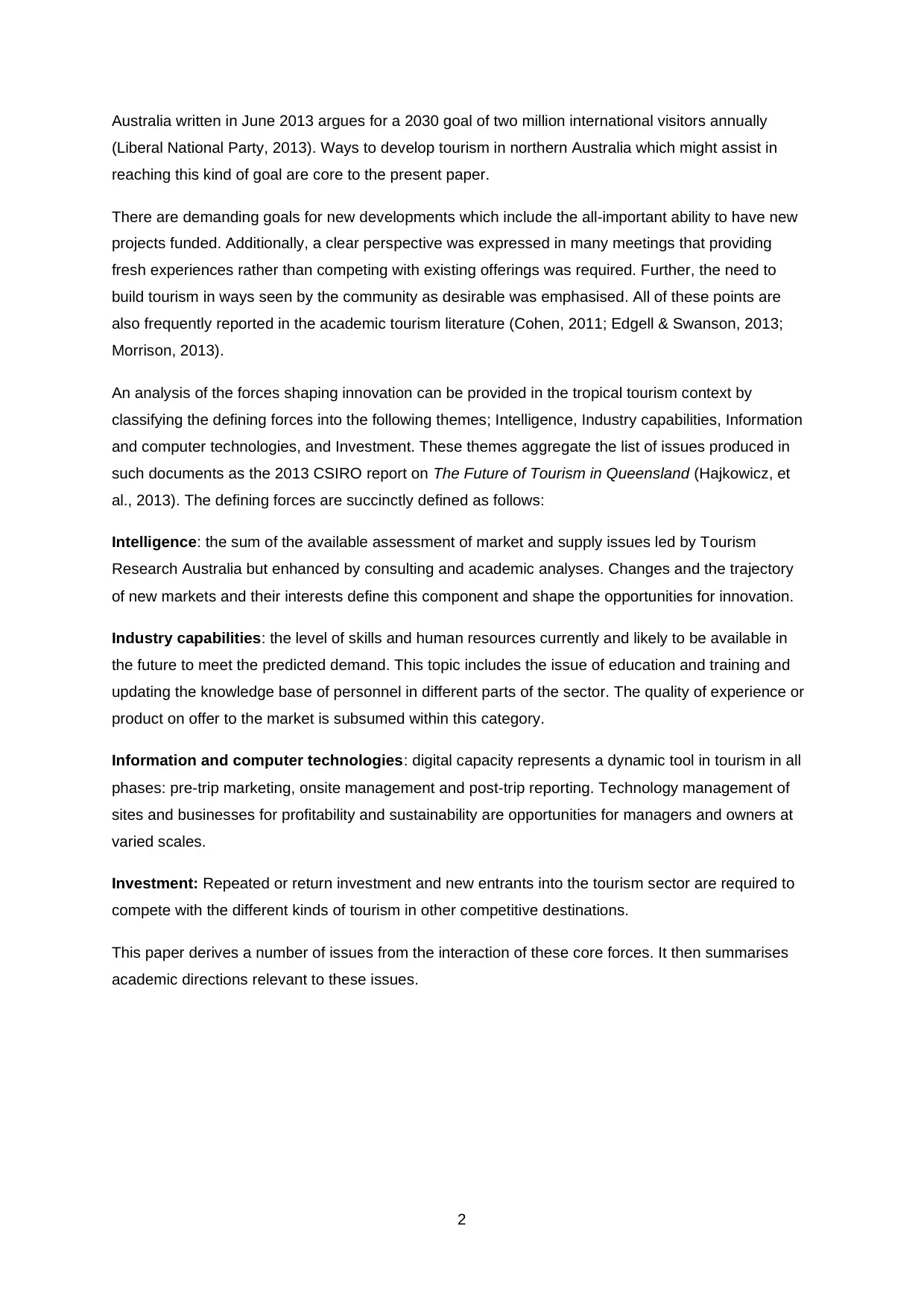
2
Australia written in June 2013 argues for a 2030 goal of two million international visitors annually
(Liberal National Party, 2013). Ways to develop tourism in northern Australia which might assist in
reaching this kind of goal are core to the present paper.
There are demanding goals for new developments which include the all-important ability to have new
projects funded. Additionally, a clear perspective was expressed in many meetings that providing
fresh experiences rather than competing with existing offerings was required. Further, the need to
build tourism in ways seen by the community as desirable was emphasised. All of these points are
also frequently reported in the academic tourism literature (Cohen, 2011; Edgell & Swanson, 2013;
Morrison, 2013).
An analysis of the forces shaping innovation can be provided in the tropical tourism context by
classifying the defining forces into the following themes; Intelligence, Industry capabilities, Information
and computer technologies, and Investment. These themes aggregate the list of issues produced in
such documents as the 2013 CSIRO report on The Future of Tourism in Queensland (Hajkowicz, et
al., 2013). The defining forces are succinctly defined as follows:
Intelligence: the sum of the available assessment of market and supply issues led by Tourism
Research Australia but enhanced by consulting and academic analyses. Changes and the trajectory
of new markets and their interests define this component and shape the opportunities for innovation.
Industry capabilities: the level of skills and human resources currently and likely to be available in
the future to meet the predicted demand. This topic includes the issue of education and training and
updating the knowledge base of personnel in different parts of the sector. The quality of experience or
product on offer to the market is subsumed within this category.
Information and computer technologies: digital capacity represents a dynamic tool in tourism in all
phases: pre-trip marketing, onsite management and post-trip reporting. Technology management of
sites and businesses for profitability and sustainability are opportunities for managers and owners at
varied scales.
Investment: Repeated or return investment and new entrants into the tourism sector are required to
compete with the different kinds of tourism in other competitive destinations.
This paper derives a number of issues from the interaction of these core forces. It then summarises
academic directions relevant to these issues.
Australia written in June 2013 argues for a 2030 goal of two million international visitors annually
(Liberal National Party, 2013). Ways to develop tourism in northern Australia which might assist in
reaching this kind of goal are core to the present paper.
There are demanding goals for new developments which include the all-important ability to have new
projects funded. Additionally, a clear perspective was expressed in many meetings that providing
fresh experiences rather than competing with existing offerings was required. Further, the need to
build tourism in ways seen by the community as desirable was emphasised. All of these points are
also frequently reported in the academic tourism literature (Cohen, 2011; Edgell & Swanson, 2013;
Morrison, 2013).
An analysis of the forces shaping innovation can be provided in the tropical tourism context by
classifying the defining forces into the following themes; Intelligence, Industry capabilities, Information
and computer technologies, and Investment. These themes aggregate the list of issues produced in
such documents as the 2013 CSIRO report on The Future of Tourism in Queensland (Hajkowicz, et
al., 2013). The defining forces are succinctly defined as follows:
Intelligence: the sum of the available assessment of market and supply issues led by Tourism
Research Australia but enhanced by consulting and academic analyses. Changes and the trajectory
of new markets and their interests define this component and shape the opportunities for innovation.
Industry capabilities: the level of skills and human resources currently and likely to be available in
the future to meet the predicted demand. This topic includes the issue of education and training and
updating the knowledge base of personnel in different parts of the sector. The quality of experience or
product on offer to the market is subsumed within this category.
Information and computer technologies: digital capacity represents a dynamic tool in tourism in all
phases: pre-trip marketing, onsite management and post-trip reporting. Technology management of
sites and businesses for profitability and sustainability are opportunities for managers and owners at
varied scales.
Investment: Repeated or return investment and new entrants into the tourism sector are required to
compete with the different kinds of tourism in other competitive destinations.
This paper derives a number of issues from the interaction of these core forces. It then summarises
academic directions relevant to these issues.
Paraphrase This Document
Need a fresh take? Get an instant paraphrase of this document with our AI Paraphraser
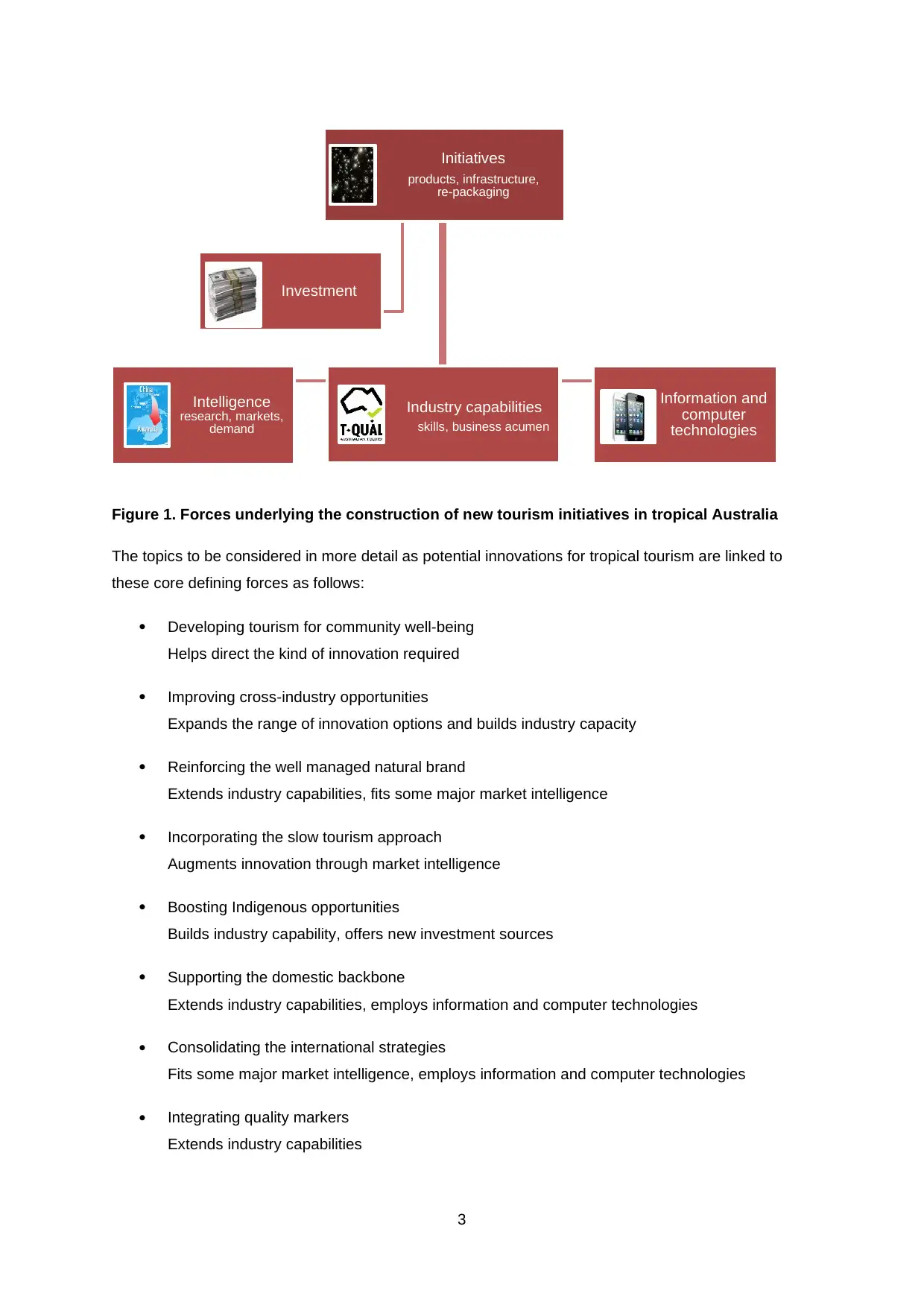
3
Figure 1. Forces underlying the construction of new tourism initiatives in tropical Australia
The topics to be considered in more detail as potential innovations for tropical tourism are linked to
these core defining forces as follows:
Developing tourism for community well-being
Helps direct the kind of innovation required
Improving cross-industry opportunities
Expands the range of innovation options and builds industry capacity
Reinforcing the well managed natural brand
Extends industry capabilities, fits some major market intelligence
Incorporating the slow tourism approach
Augments innovation through market intelligence
Boosting Indigenous opportunities
Builds industry capability, offers new investment sources
Supporting the domestic backbone
Extends industry capabilities, employs information and computer technologies
Consolidating the international strategies
Fits some major market intelligence, employs information and computer technologies
Integrating quality markers
Extends industry capabilities
Initiatives
products, infrastructure,
re-packaging
Intelligence
research, markets,
demand
Industry capabilities
skills, business acumen
Information and
computer
technologies
Investment
Figure 1. Forces underlying the construction of new tourism initiatives in tropical Australia
The topics to be considered in more detail as potential innovations for tropical tourism are linked to
these core defining forces as follows:
Developing tourism for community well-being
Helps direct the kind of innovation required
Improving cross-industry opportunities
Expands the range of innovation options and builds industry capacity
Reinforcing the well managed natural brand
Extends industry capabilities, fits some major market intelligence
Incorporating the slow tourism approach
Augments innovation through market intelligence
Boosting Indigenous opportunities
Builds industry capability, offers new investment sources
Supporting the domestic backbone
Extends industry capabilities, employs information and computer technologies
Consolidating the international strategies
Fits some major market intelligence, employs information and computer technologies
Integrating quality markers
Extends industry capabilities
Initiatives
products, infrastructure,
re-packaging
Intelligence
research, markets,
demand
Industry capabilities
skills, business acumen
Information and
computer
technologies
Investment
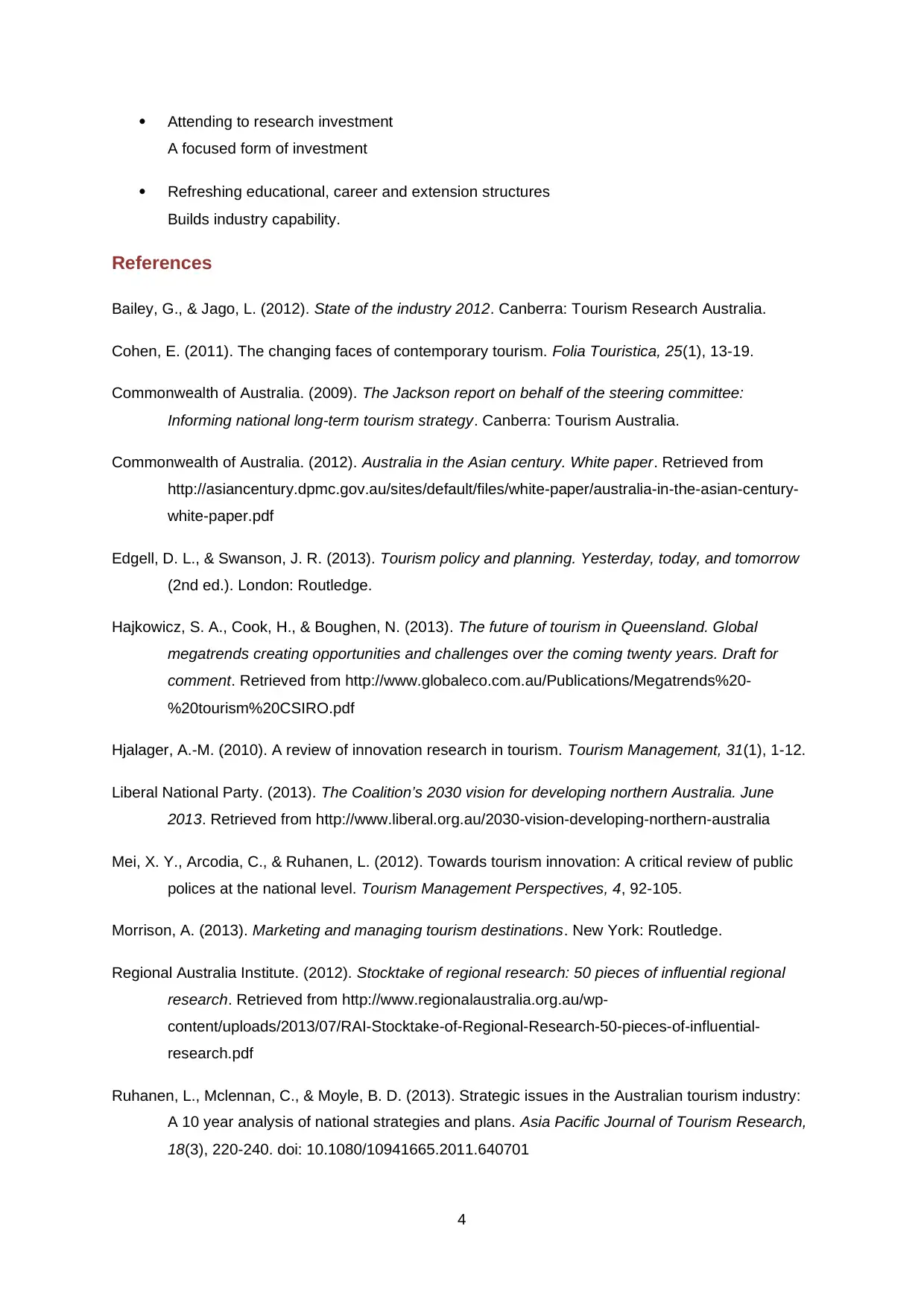
4
Attending to research investment
A focused form of investment
Refreshing educational, career and extension structures
Builds industry capability.
References
Bailey, G., & Jago, L. (2012). State of the industry 2012. Canberra: Tourism Research Australia.
Cohen, E. (2011). The changing faces of contemporary tourism. Folia Touristica, 25(1), 13-19.
Commonwealth of Australia. (2009). The Jackson report on behalf of the steering committee:
Informing national long-term tourism strategy. Canberra: Tourism Australia.
Commonwealth of Australia. (2012). Australia in the Asian century. White paper. Retrieved from
http://asiancentury.dpmc.gov.au/sites/default/files/white-paper/australia-in-the-asian-century-
white-paper.pdf
Edgell, D. L., & Swanson, J. R. (2013). Tourism policy and planning. Yesterday, today, and tomorrow
(2nd ed.). London: Routledge.
Hajkowicz, S. A., Cook, H., & Boughen, N. (2013). The future of tourism in Queensland. Global
megatrends creating opportunities and challenges over the coming twenty years. Draft for
comment. Retrieved from http://www.globaleco.com.au/Publications/Megatrends%20-
%20tourism%20CSIRO.pdf
Hjalager, A.-M. (2010). A review of innovation research in tourism. Tourism Management, 31(1), 1-12.
Liberal National Party. (2013). The Coalition’s 2030 vision for developing northern Australia. June
2013. Retrieved from http://www.liberal.org.au/2030-vision-developing-northern-australia
Mei, X. Y., Arcodia, C., & Ruhanen, L. (2012). Towards tourism innovation: A critical review of public
polices at the national level. Tourism Management Perspectives, 4, 92-105.
Morrison, A. (2013). Marketing and managing tourism destinations. New York: Routledge.
Regional Australia Institute. (2012). Stocktake of regional research: 50 pieces of influential regional
research. Retrieved from http://www.regionalaustralia.org.au/wp-
content/uploads/2013/07/RAI-Stocktake-of-Regional-Research-50-pieces-of-influential-
research.pdf
Ruhanen, L., Mclennan, C., & Moyle, B. D. (2013). Strategic issues in the Australian tourism industry:
A 10 year analysis of national strategies and plans. Asia Pacific Journal of Tourism Research,
18(3), 220-240. doi: 10.1080/10941665.2011.640701
Attending to research investment
A focused form of investment
Refreshing educational, career and extension structures
Builds industry capability.
References
Bailey, G., & Jago, L. (2012). State of the industry 2012. Canberra: Tourism Research Australia.
Cohen, E. (2011). The changing faces of contemporary tourism. Folia Touristica, 25(1), 13-19.
Commonwealth of Australia. (2009). The Jackson report on behalf of the steering committee:
Informing national long-term tourism strategy. Canberra: Tourism Australia.
Commonwealth of Australia. (2012). Australia in the Asian century. White paper. Retrieved from
http://asiancentury.dpmc.gov.au/sites/default/files/white-paper/australia-in-the-asian-century-
white-paper.pdf
Edgell, D. L., & Swanson, J. R. (2013). Tourism policy and planning. Yesterday, today, and tomorrow
(2nd ed.). London: Routledge.
Hajkowicz, S. A., Cook, H., & Boughen, N. (2013). The future of tourism in Queensland. Global
megatrends creating opportunities and challenges over the coming twenty years. Draft for
comment. Retrieved from http://www.globaleco.com.au/Publications/Megatrends%20-
%20tourism%20CSIRO.pdf
Hjalager, A.-M. (2010). A review of innovation research in tourism. Tourism Management, 31(1), 1-12.
Liberal National Party. (2013). The Coalition’s 2030 vision for developing northern Australia. June
2013. Retrieved from http://www.liberal.org.au/2030-vision-developing-northern-australia
Mei, X. Y., Arcodia, C., & Ruhanen, L. (2012). Towards tourism innovation: A critical review of public
polices at the national level. Tourism Management Perspectives, 4, 92-105.
Morrison, A. (2013). Marketing and managing tourism destinations. New York: Routledge.
Regional Australia Institute. (2012). Stocktake of regional research: 50 pieces of influential regional
research. Retrieved from http://www.regionalaustralia.org.au/wp-
content/uploads/2013/07/RAI-Stocktake-of-Regional-Research-50-pieces-of-influential-
research.pdf
Ruhanen, L., Mclennan, C., & Moyle, B. D. (2013). Strategic issues in the Australian tourism industry:
A 10 year analysis of national strategies and plans. Asia Pacific Journal of Tourism Research,
18(3), 220-240. doi: 10.1080/10941665.2011.640701
⊘ This is a preview!⊘
Do you want full access?
Subscribe today to unlock all pages.

Trusted by 1+ million students worldwide
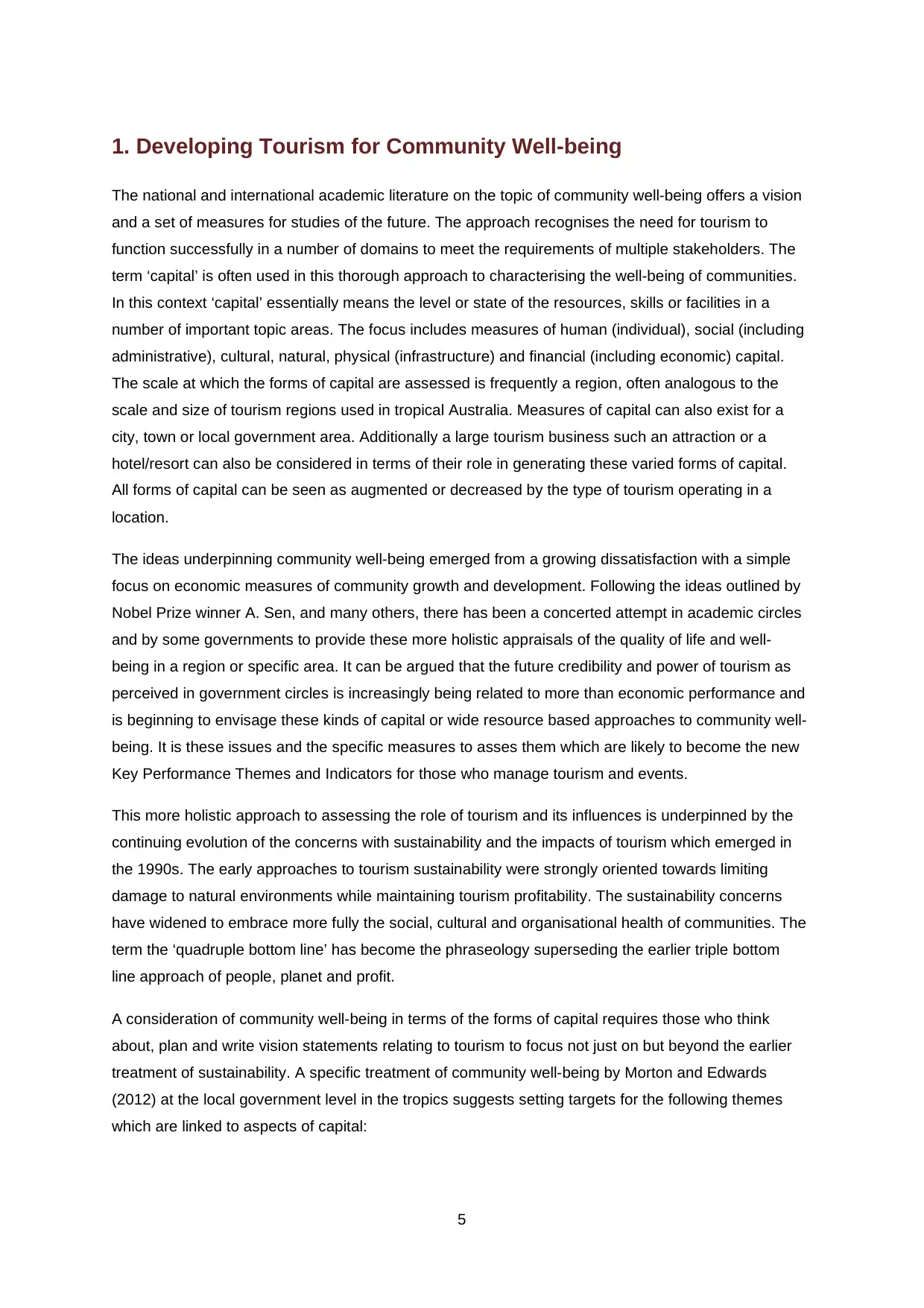
5
1. Developing Tourism for Community Well-being
The national and international academic literature on the topic of community well-being offers a vision
and a set of measures for studies of the future. The approach recognises the need for tourism to
function successfully in a number of domains to meet the requirements of multiple stakeholders. The
term ‘capital’ is often used in this thorough approach to characterising the well-being of communities.
In this context ‘capital’ essentially means the level or state of the resources, skills or facilities in a
number of important topic areas. The focus includes measures of human (individual), social (including
administrative), cultural, natural, physical (infrastructure) and financial (including economic) capital.
The scale at which the forms of capital are assessed is frequently a region, often analogous to the
scale and size of tourism regions used in tropical Australia. Measures of capital can also exist for a
city, town or local government area. Additionally a large tourism business such an attraction or a
hotel/resort can also be considered in terms of their role in generating these varied forms of capital.
All forms of capital can be seen as augmented or decreased by the type of tourism operating in a
location.
The ideas underpinning community well-being emerged from a growing dissatisfaction with a simple
focus on economic measures of community growth and development. Following the ideas outlined by
Nobel Prize winner A. Sen, and many others, there has been a concerted attempt in academic circles
and by some governments to provide these more holistic appraisals of the quality of life and well-
being in a region or specific area. It can be argued that the future credibility and power of tourism as
perceived in government circles is increasingly being related to more than economic performance and
is beginning to envisage these kinds of capital or wide resource based approaches to community well-
being. It is these issues and the specific measures to asses them which are likely to become the new
Key Performance Themes and Indicators for those who manage tourism and events.
This more holistic approach to assessing the role of tourism and its influences is underpinned by the
continuing evolution of the concerns with sustainability and the impacts of tourism which emerged in
the 1990s. The early approaches to tourism sustainability were strongly oriented towards limiting
damage to natural environments while maintaining tourism profitability. The sustainability concerns
have widened to embrace more fully the social, cultural and organisational health of communities. The
term the ‘quadruple bottom line’ has become the phraseology superseding the earlier triple bottom
line approach of people, planet and profit.
A consideration of community well-being in terms of the forms of capital requires those who think
about, plan and write vision statements relating to tourism to focus not just on but beyond the earlier
treatment of sustainability. A specific treatment of community well-being by Morton and Edwards
(2012) at the local government level in the tropics suggests setting targets for the following themes
which are linked to aspects of capital:
1. Developing Tourism for Community Well-being
The national and international academic literature on the topic of community well-being offers a vision
and a set of measures for studies of the future. The approach recognises the need for tourism to
function successfully in a number of domains to meet the requirements of multiple stakeholders. The
term ‘capital’ is often used in this thorough approach to characterising the well-being of communities.
In this context ‘capital’ essentially means the level or state of the resources, skills or facilities in a
number of important topic areas. The focus includes measures of human (individual), social (including
administrative), cultural, natural, physical (infrastructure) and financial (including economic) capital.
The scale at which the forms of capital are assessed is frequently a region, often analogous to the
scale and size of tourism regions used in tropical Australia. Measures of capital can also exist for a
city, town or local government area. Additionally a large tourism business such an attraction or a
hotel/resort can also be considered in terms of their role in generating these varied forms of capital.
All forms of capital can be seen as augmented or decreased by the type of tourism operating in a
location.
The ideas underpinning community well-being emerged from a growing dissatisfaction with a simple
focus on economic measures of community growth and development. Following the ideas outlined by
Nobel Prize winner A. Sen, and many others, there has been a concerted attempt in academic circles
and by some governments to provide these more holistic appraisals of the quality of life and well-
being in a region or specific area. It can be argued that the future credibility and power of tourism as
perceived in government circles is increasingly being related to more than economic performance and
is beginning to envisage these kinds of capital or wide resource based approaches to community well-
being. It is these issues and the specific measures to asses them which are likely to become the new
Key Performance Themes and Indicators for those who manage tourism and events.
This more holistic approach to assessing the role of tourism and its influences is underpinned by the
continuing evolution of the concerns with sustainability and the impacts of tourism which emerged in
the 1990s. The early approaches to tourism sustainability were strongly oriented towards limiting
damage to natural environments while maintaining tourism profitability. The sustainability concerns
have widened to embrace more fully the social, cultural and organisational health of communities. The
term the ‘quadruple bottom line’ has become the phraseology superseding the earlier triple bottom
line approach of people, planet and profit.
A consideration of community well-being in terms of the forms of capital requires those who think
about, plan and write vision statements relating to tourism to focus not just on but beyond the earlier
treatment of sustainability. A specific treatment of community well-being by Morton and Edwards
(2012) at the local government level in the tropics suggests setting targets for the following themes
which are linked to aspects of capital:
Paraphrase This Document
Need a fresh take? Get an instant paraphrase of this document with our AI Paraphraser
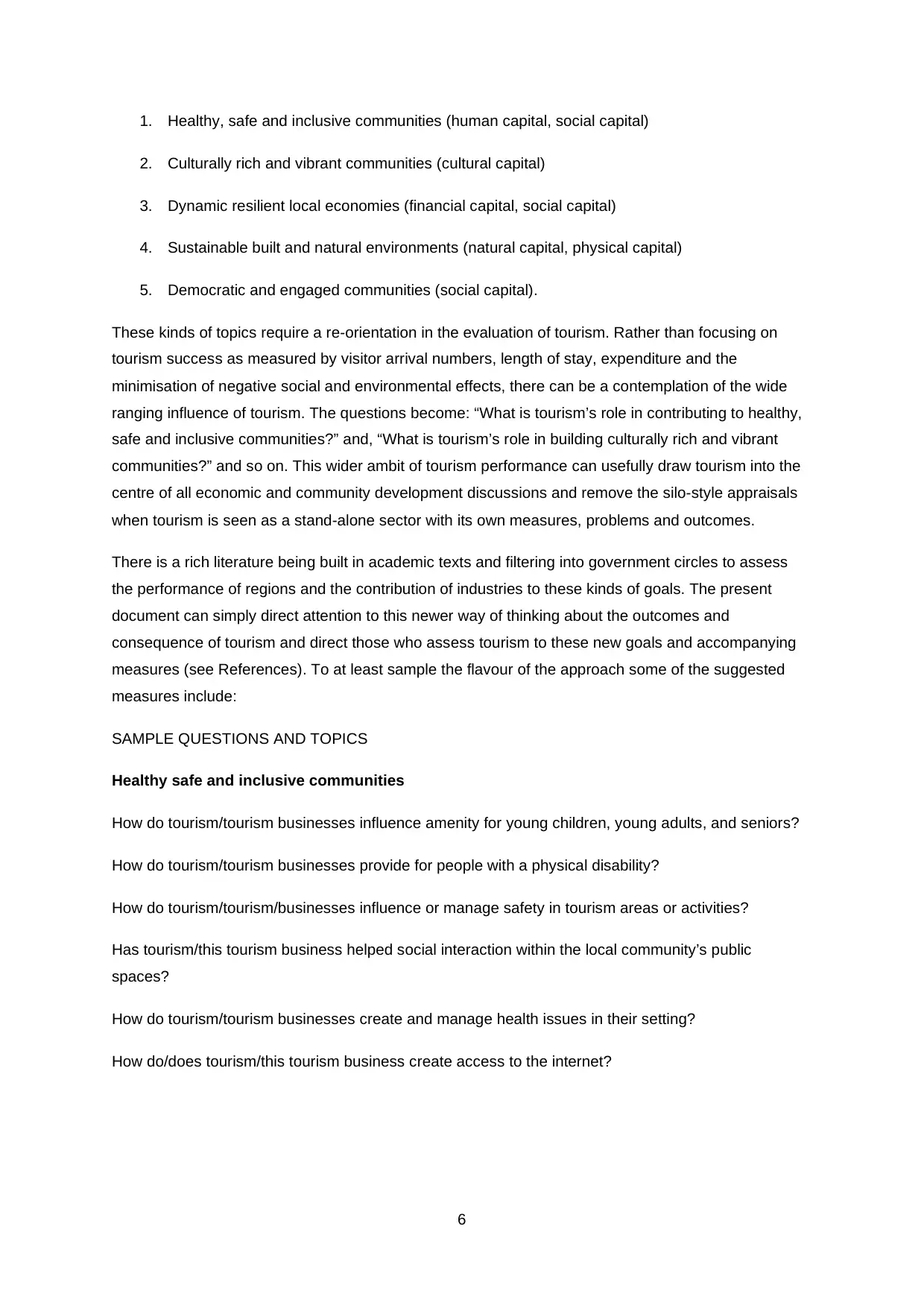
6
1. Healthy, safe and inclusive communities (human capital, social capital)
2. Culturally rich and vibrant communities (cultural capital)
3. Dynamic resilient local economies (financial capital, social capital)
4. Sustainable built and natural environments (natural capital, physical capital)
5. Democratic and engaged communities (social capital).
These kinds of topics require a re-orientation in the evaluation of tourism. Rather than focusing on
tourism success as measured by visitor arrival numbers, length of stay, expenditure and the
minimisation of negative social and environmental effects, there can be a contemplation of the wide
ranging influence of tourism. The questions become: “What is tourism’s role in contributing to healthy,
safe and inclusive communities?” and, “What is tourism’s role in building culturally rich and vibrant
communities?” and so on. This wider ambit of tourism performance can usefully draw tourism into the
centre of all economic and community development discussions and remove the silo-style appraisals
when tourism is seen as a stand-alone sector with its own measures, problems and outcomes.
There is a rich literature being built in academic texts and filtering into government circles to assess
the performance of regions and the contribution of industries to these kinds of goals. The present
document can simply direct attention to this newer way of thinking about the outcomes and
consequence of tourism and direct those who assess tourism to these new goals and accompanying
measures (see References). To at least sample the flavour of the approach some of the suggested
measures include:
SAMPLE QUESTIONS AND TOPICS
Healthy safe and inclusive communities
How do tourism/tourism businesses influence amenity for young children, young adults, and seniors?
How do tourism/tourism businesses provide for people with a physical disability?
How do tourism/tourism/businesses influence or manage safety in tourism areas or activities?
Has tourism/this tourism business helped social interaction within the local community’s public
spaces?
How do tourism/tourism businesses create and manage health issues in their setting?
How do/does tourism/this tourism business create access to the internet?
1. Healthy, safe and inclusive communities (human capital, social capital)
2. Culturally rich and vibrant communities (cultural capital)
3. Dynamic resilient local economies (financial capital, social capital)
4. Sustainable built and natural environments (natural capital, physical capital)
5. Democratic and engaged communities (social capital).
These kinds of topics require a re-orientation in the evaluation of tourism. Rather than focusing on
tourism success as measured by visitor arrival numbers, length of stay, expenditure and the
minimisation of negative social and environmental effects, there can be a contemplation of the wide
ranging influence of tourism. The questions become: “What is tourism’s role in contributing to healthy,
safe and inclusive communities?” and, “What is tourism’s role in building culturally rich and vibrant
communities?” and so on. This wider ambit of tourism performance can usefully draw tourism into the
centre of all economic and community development discussions and remove the silo-style appraisals
when tourism is seen as a stand-alone sector with its own measures, problems and outcomes.
There is a rich literature being built in academic texts and filtering into government circles to assess
the performance of regions and the contribution of industries to these kinds of goals. The present
document can simply direct attention to this newer way of thinking about the outcomes and
consequence of tourism and direct those who assess tourism to these new goals and accompanying
measures (see References). To at least sample the flavour of the approach some of the suggested
measures include:
SAMPLE QUESTIONS AND TOPICS
Healthy safe and inclusive communities
How do tourism/tourism businesses influence amenity for young children, young adults, and seniors?
How do tourism/tourism businesses provide for people with a physical disability?
How do tourism/tourism/businesses influence or manage safety in tourism areas or activities?
Has tourism/this tourism business helped social interaction within the local community’s public
spaces?
How do tourism/tourism businesses create and manage health issues in their setting?
How do/does tourism/this tourism business create access to the internet?
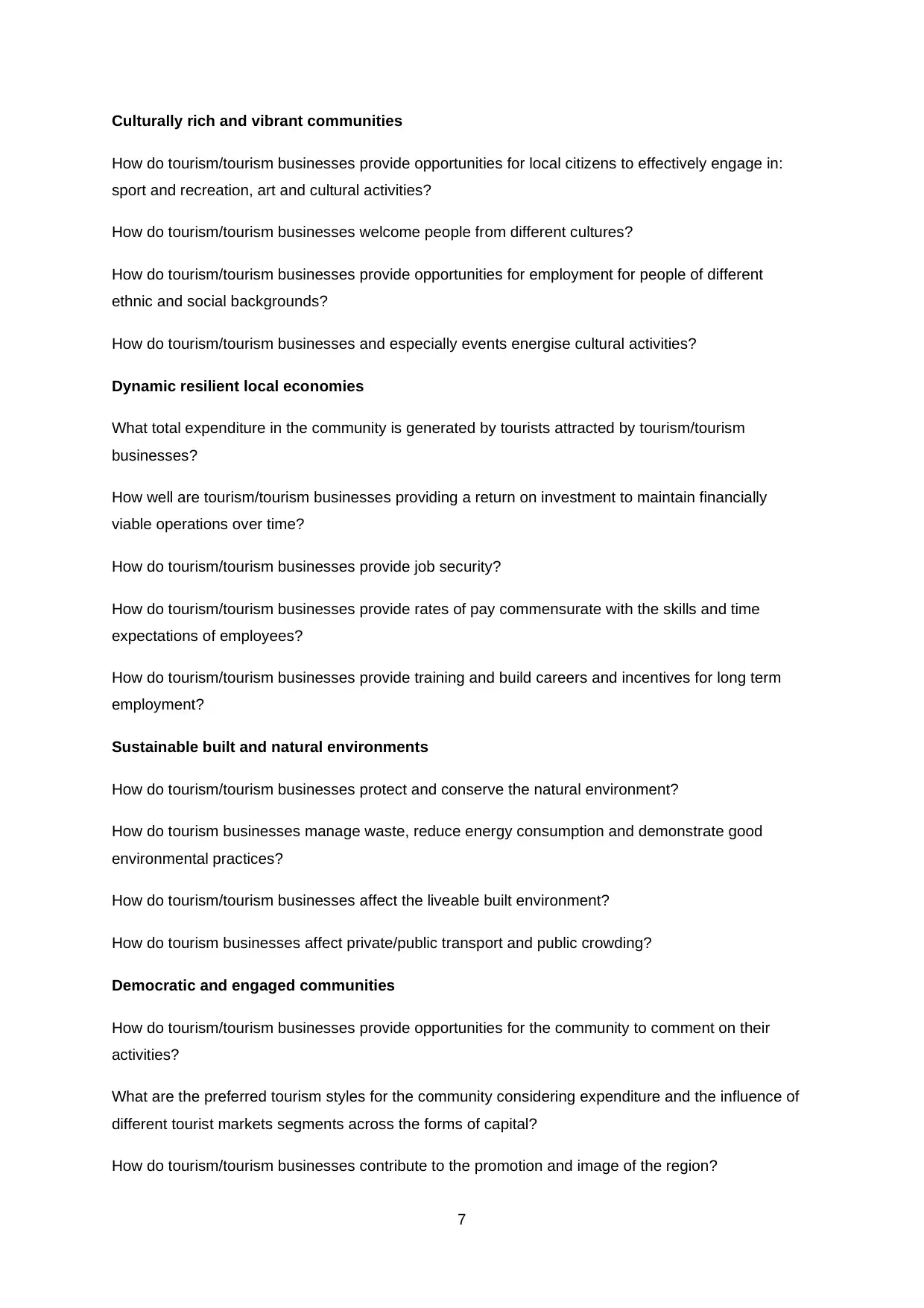
7
Culturally rich and vibrant communities
How do tourism/tourism businesses provide opportunities for local citizens to effectively engage in:
sport and recreation, art and cultural activities?
How do tourism/tourism businesses welcome people from different cultures?
How do tourism/tourism businesses provide opportunities for employment for people of different
ethnic and social backgrounds?
How do tourism/tourism businesses and especially events energise cultural activities?
Dynamic resilient local economies
What total expenditure in the community is generated by tourists attracted by tourism/tourism
businesses?
How well are tourism/tourism businesses providing a return on investment to maintain financially
viable operations over time?
How do tourism/tourism businesses provide job security?
How do tourism/tourism businesses provide rates of pay commensurate with the skills and time
expectations of employees?
How do tourism/tourism businesses provide training and build careers and incentives for long term
employment?
Sustainable built and natural environments
How do tourism/tourism businesses protect and conserve the natural environment?
How do tourism businesses manage waste, reduce energy consumption and demonstrate good
environmental practices?
How do tourism/tourism businesses affect the liveable built environment?
How do tourism businesses affect private/public transport and public crowding?
Democratic and engaged communities
How do tourism/tourism businesses provide opportunities for the community to comment on their
activities?
What are the preferred tourism styles for the community considering expenditure and the influence of
different tourist markets segments across the forms of capital?
How do tourism/tourism businesses contribute to the promotion and image of the region?
Culturally rich and vibrant communities
How do tourism/tourism businesses provide opportunities for local citizens to effectively engage in:
sport and recreation, art and cultural activities?
How do tourism/tourism businesses welcome people from different cultures?
How do tourism/tourism businesses provide opportunities for employment for people of different
ethnic and social backgrounds?
How do tourism/tourism businesses and especially events energise cultural activities?
Dynamic resilient local economies
What total expenditure in the community is generated by tourists attracted by tourism/tourism
businesses?
How well are tourism/tourism businesses providing a return on investment to maintain financially
viable operations over time?
How do tourism/tourism businesses provide job security?
How do tourism/tourism businesses provide rates of pay commensurate with the skills and time
expectations of employees?
How do tourism/tourism businesses provide training and build careers and incentives for long term
employment?
Sustainable built and natural environments
How do tourism/tourism businesses protect and conserve the natural environment?
How do tourism businesses manage waste, reduce energy consumption and demonstrate good
environmental practices?
How do tourism/tourism businesses affect the liveable built environment?
How do tourism businesses affect private/public transport and public crowding?
Democratic and engaged communities
How do tourism/tourism businesses provide opportunities for the community to comment on their
activities?
What are the preferred tourism styles for the community considering expenditure and the influence of
different tourist markets segments across the forms of capital?
How do tourism/tourism businesses contribute to the promotion and image of the region?
⊘ This is a preview!⊘
Do you want full access?
Subscribe today to unlock all pages.

Trusted by 1+ million students worldwide
1 out of 57
Your All-in-One AI-Powered Toolkit for Academic Success.
+13062052269
info@desklib.com
Available 24*7 on WhatsApp / Email
![[object Object]](/_next/static/media/star-bottom.7253800d.svg)
Unlock your academic potential
Copyright © 2020–2025 A2Z Services. All Rights Reserved. Developed and managed by ZUCOL.
